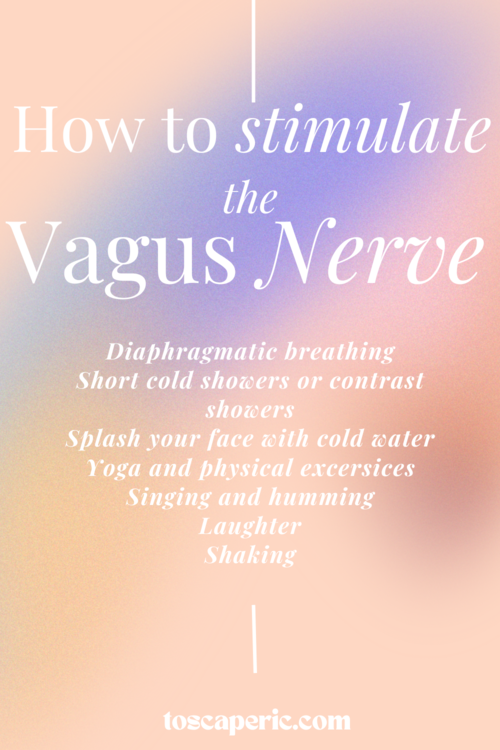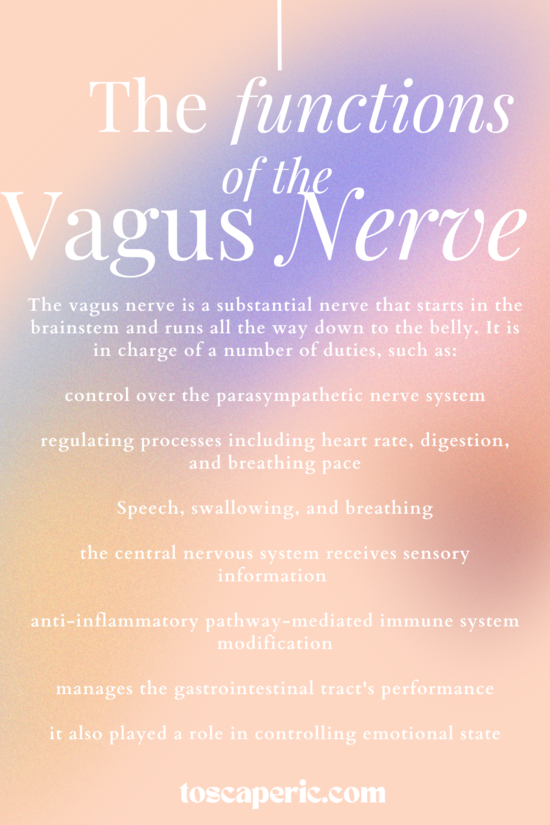I am Tosca
Welcome Goddess!
The Vagus Nerve & Breathwork
The vagus nerve, one of the longest in the human body, extends from the brainstem to the stomach. Control of several bodily functions, such as digestion, heart rhythm, and immune response, depend on it.
In the intricate labyrinth of our body’s nervous system, there’s a fascinating highway that holds the key to our physical and mental well-being – the vagus nerve. Often referred to as the body’s “superhighway of relaxation,” the vagus nerve plays a vital role in maintaining our equilibrium and managing stress. In this captivating exploration, we’ll delve into the world of the vagus nerve and its profound connection with the art of breathwork. Brace yourself for a journey that unlocks the potential of your inner tranquility and reveals the magic of conscious breathing.
Researchers have discovered that the vagus nerve is also essential in regulating our emotional and mental well-being because of its connection to the parasympathetic nervous system.
Breathwork is one of the best techniques to engage the parasympathetic nervous system and stimulate the vagus nerve. Conscious, regulated breathing is a component of the meditation practice known as breathwork. It has been demonstrated to lessen stress, boost mood, and even lessen the signs of sadness and anxiety.
The Vagus Nerve: Navigating the Pathways of Balance Hidden
Within the labyrinth of our nervous system, the vagus nerve, named after the Latin word for “wandering,” does exactly that – it winds its way through various organs, acting as a communication line between the brain and the body. This remarkable nerve regulates a multitude of functions, from heart rate and digestion to our emotional responses and immune system. Think of it as a conductor of your body’s symphony, orchestrating a harmonious melody of health.

The Breathwork Connection:
Imagine your breath as the rhythm of your body’s symphony, conducted by the vagus nerve. This is where breathwork takes center stage. Through conscious and intentional breathing techniques, we can stimulate the vagus nerve’s parasympathetic response, the rest-and-digest mode that counterbalances stress. Whether it’s deep diaphragmatic breathing, alternate nostril breathing, or the ancient practice of pranayama, breathwork provides us with a profound tool to tap into our body’s innate ability to find balance.
It’s not just about calming down a racing heart or soothing frayed nerves; it’s about unleashing a cascade of healing responses that ripple through every cell. Enhanced digestion, reduced inflammation, improved mood, and increased resilience against stress are just a few of the enchanting benefits of this dance.
Exploring Breathwork Practices:
A Journey Within Embarking on a breathwork journey is an invitation to explore the vast landscapes of your inner world. Whether you’re drawn to pranayama, guided breathwork sessions, or simply sitting in quiet meditation, each technique offers a unique path to ignite the vagus nerve’s magic. As you learn to ride the waves of your breath, you’ll find yourself sailing toward tranquility and embracing a sense of empowerment over your own nervous system.

Diaphragmatic breathing
Diaphragmatic breathing, sometimes known as “belly breathing,” is one of the most well-known types of breathwork. To use this method, choose a comfortable sitting or lying posture and lay one hand on your abdomen and the other on your chest. After that, take a long, deep breath in through your nose, causing your belly to rise as your diaphragm contracts. Exhale via your lips, letting your tummy droop as your diaphragm is squeezed. For many minutes, keep up this rhythm.
Nadi Shodhana
Alternate nostril breathing sometimes referred to as “Nadi shodhana,” is a further well-liked breathwork technique. In order to use this method, you must close one nostril at a time while inhaling and exhaling.
You may accomplish this by placing your fingers on the sides of your nose or by simply covering one nostril with your thumb.
According to this method, the left and right hemispheres of the brain are balanced, and serenity and equilibrium are also encouraged.
These kinds of breathing exercises have been shown to stimulate the vagus nerve and subsequently the parasympathetic nervous system. This may result in a reduction in heart rate, an increase in gastrointestinal motility and immune response control, a general reduction in stress, and an improvement in emotions of well-being.
Breathwork may not be suitable or secure for everyone, especially those with respiratory or cardiovascular issues. Before attempting new breathing exercises, check with your doctor if you have a medical problem or are on any drugs.

In conclusion, the vagus nerve is crucial in controlling a variety of biological processes, such as our emotional and mental health. One of the best methods to engage the parasympathetic nervous system and stimulate the vagus nerve is through breathwork. You may reduce stress, elevate your mood, and feel more at ease all around by including breathwork in your everyday routine.
I wish you lots of awareness.
Namasté,
Tosca






